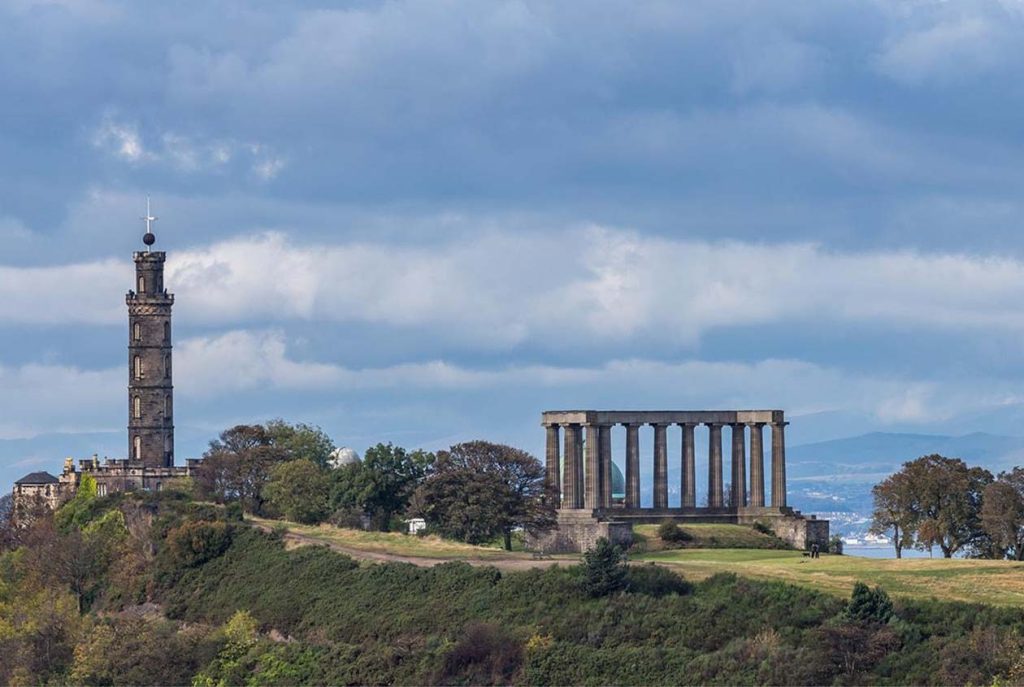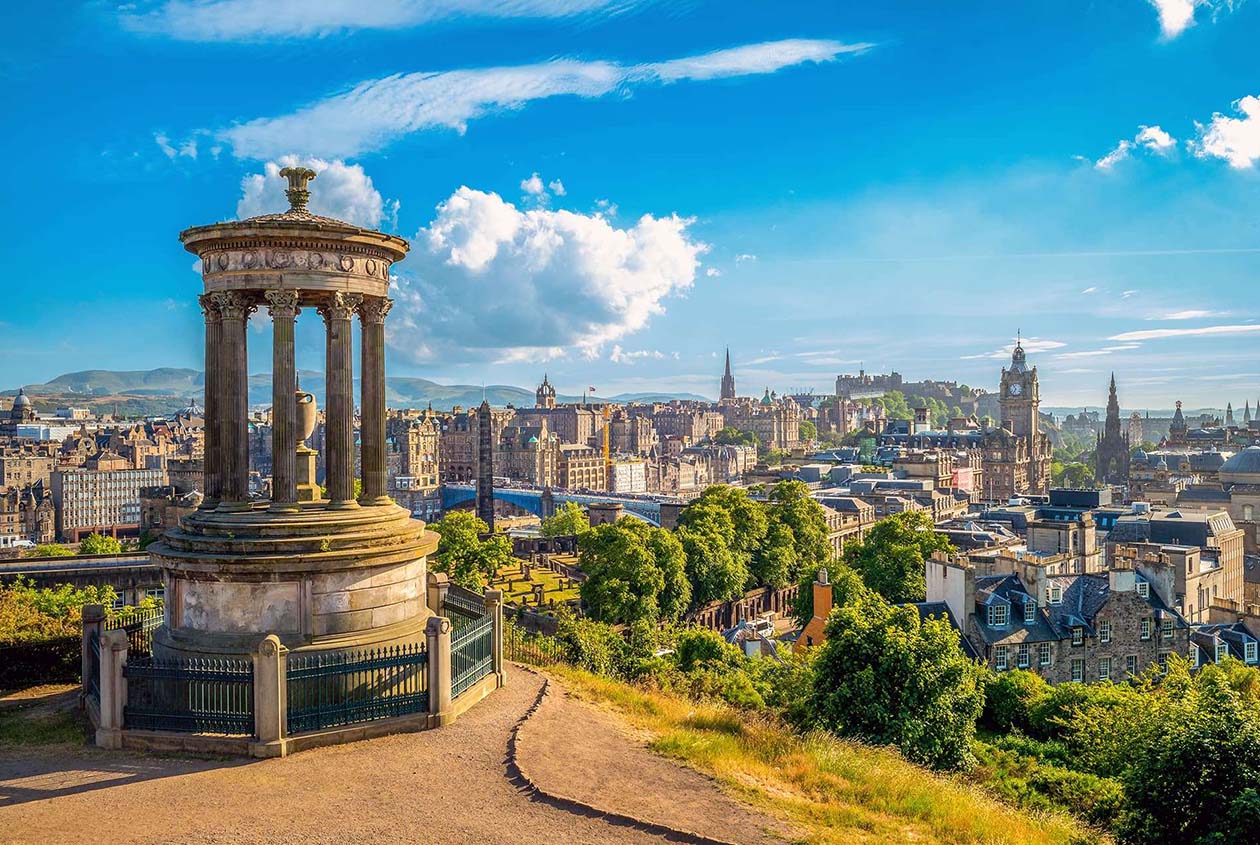I recently had the privilege of exploring Calton Hill, a prominent hill in the heart of Edinburgh. This picturesque location has earned a reputation as one of the city’s finest spots for hiking and climbing, offering breathtaking panoramic views and a rich history. I’ll recount my personal experiences at three remarkable points of interest on Calton Hill and recommend four additional must-visit spots. We’ll explore their significance, services, pros and cons, specific geographical locations, routes to access them, any available discounts or offers, ticket prices, recommendation ratings, and booking platforms. Join me as we embark on a journey through Calton Hill’s captivating landscapes.
My Adventures on Calton Hill:
1. Nelson Monument:
Situated on Calton Hill at Edinburgh EH7 5AA, Scotland, the Nelson Monument is a remarkable structure that pays tribute to Admiral Lord Nelson, an esteemed figure in British naval history. This iconic tower stands as a testament to his contributions and serves as a prominent landmark within the city.
As I made my way to Calton Hill, the monument’s towering presence was immediately noticeable against the Edinburgh skyline. Its distinctive design, characterized by a slender tower topped with a striking ball structure, draws the eye and beckons visitors to explore its interior.
Upon reaching the Nelson Monument, I eagerly embarked on the ascent via its narrow staircase, which winds its way upward through the heart of the tower. The climb, though somewhat steep, was a manageable endeavor, and the promise of breathtaking views from the top fueled my enthusiasm.

Reaching the summit was a truly exhilarating experience. From this elevated vantage point, I found myself immersed in a 360-degree panorama that stretched as far as the eye could see. The view was, without a doubt, awe-inspiring. The Edinburgh cityscape lay before me in all its glory, a tapestry of historic and modern architecture set against the backdrop of rolling hills and the Firth of Forth.
One of the standout features of this vista was the commanding presence of Edinburgh Castle, perched atop Castle Rock and casting its timeless shadow over the city. The ancient stronghold, with its historic significance and formidable beauty, was a captivating sight from this unique perspective.
In the distance, Arthur’s Seat, Edinburgh’s dormant volcano and a beloved natural landmark, rose majestically from the earth. Its distinctive profile against the sky was a reminder of the city’s harmonious blend of urban and natural landscapes.
As I gazed out from the Nelson Monument, I couldn’t help but marvel at the city’s topography, which seemed to tell a story of centuries past. The intertwining streets, the picturesque Princes Street Gardens, and the historic Royal Mile all came into view, providing a tangible connection to Edinburgh’s rich history and culture.
In addition to the city’s architectural splendor, the natural beauty of the surrounding countryside was equally captivating. The Firth of Forth, with its shimmering waters and distant shores, added a touch of serenity to the urban landscape.
2. Dugald Stewart Monument:
Location: Calton Hill, Edinburgh EH7 5AA, Scotland
The Dugald Stewart Monument, named after the Scottish philosopher Dugald Stewart, is a neoclassical structure with an impressive dome and commanding columns. It stands as a tribute to intellectual enlightenment.
The monument’s design and location make it a captivating sight. I found the neoclassical architecture to be a stark contrast to the rugged natural beauty of Calton Hill. I spent some time exploring the surrounding area and taking in the serene atmosphere. The Dugald Stewart Monument serves as a reminder of Edinburgh’s historical significance in the world of philosophy and education.
3. The City Observatory:
The City Observatory on Calton Hill, Edinburgh EH7 5AA, Scotland, is a treasure trove of scientific heritage and a testament to the city’s deep-rooted connection with astronomical research. With its roots dating back to the late 18th century, this historic observatory has played a pivotal role in advancing our understanding of the cosmos.
As I approached the City Observatory on Calton Hill, I was struck by its timeless charm and historical significance. The observatory’s location on this elevated vantage point is not only symbolic but also practical, as it allows for unobstructed views of the night sky, a crucial aspect of astronomical research.
Upon entering the observatory, I was transported back in time to an era when astronomy was still in its infancy. Antique telescopes, meticulously preserved, adorned the observatory’s interior, providing a glimpse into the tools that astronomers of yesteryears used to explore the heavens. These telescopes, with their brass fittings and ornate craftsmanship, stood as relics of a bygone era, a testament to the relentless pursuit of knowledge.
Exploring the City Observatory was a fascinating journey through the annals of scientific history. Informative displays and exhibits shed light on the contributions of Edinburgh’s astronomers to the field of astronomy. It was remarkable to learn about the pivotal discoveries made within these very walls, including the observation of celestial phenomena and the measurement of the stars.
One of the highlights of my visit was the opportunity to peer through a historic telescope and experience a slice of the astronomer’s world. As I directed the telescope towards the night sky, distant stars and celestial bodies came into view, each a silent witness to the countless hours of observation conducted from this very spot.
The observatory also boasts yet another exceptional feature: its position as a superb vantage point for taking in the cityscape. From this elevated perch, the panoramic view of Edinburgh was nothing short of breathtaking. The city’s landmarks, from Edinburgh Castle to Arthur’s Seat, were beautifully framed against the backdrop of a star-studded sky. It was a unique fusion of science and beauty, where one could contemplate the mysteries of the universe while embracing the splendor of the earthly realm.
Four Recommended Points of Interest:
1. Calton Hill’s Summit:
Location: Calton Hill, Edinburgh EH7 5AA, Scotland
The summit of Calton Hill is a natural viewpoint that doesn’t require any specific monument or structure. It’s a serene spot where you can sit and admire the city, the Firth of Forth, and the rolling hills beyond.
Services: Calton Hill’s summit offers no services in the traditional sense, but its natural beauty and tranquility make it a must-visit for anyone seeking a moment of peaceful reflection.
Pros: The summit provides an unobstructed view of Edinburgh’s skyline and natural surroundings, making it an ideal place for relaxation and photography.
Cons: It may not be as easily accessible as some of the monuments on Calton Hill, as it involves a short uphill walk.
2. Robert Burns Monument:
Location: Calton Hill, Edinburgh EH7 5AA, Scotland
The Robert Burns Monument is a tribute to Scotland’s national poet, Robert Burns. It features a striking circular temple design and provides a fitting homage to the literary giant.

Services: The monument doesn’t offer specific services but is a fascinating piece of Scottish cultural history.
Pros: It’s a place of cultural significance, allowing visitors to pay homage to one of Scotland’s most celebrated poets.
Cons: The Robert Burns Monument may not offer the same panoramic views as some of the other points of interest on Calton Hill.
3. The Athenaeum:
Location: 6 Buccleuch Pl, Edinburgh EH8 9LJ, Scotland
The Athenaeum is an iconic building adjacent to Calton Hill. It’s a historic institution dedicated to the promotion of science and literature.
Services: While not a traditional tourist attraction, the Athenaeum occasionally hosts events, lectures, and exhibitions related to science and culture.
Pros: It’s a place of intellectual and historical importance, offering a glimpse into Edinburgh’s legacy of intellectual enlightenment.
Cons: The Athenaeum may not be open to the public at all times, so it’s advisable to check for events or exhibitions during your visit.
4. Regent Road Park:
Location: Regent Rd, Edinburgh EH7 5AA, Scotland
Regent Road Park is a green space adjacent to Calton Hill, offering a peaceful oasis amidst the urban landscape.
Services: The park provides a serene environment for picnics, leisurely walks, and relaxation.
Pros: It’s a tranquil escape from the city’s hustle and bustle,
and it’s conveniently located near Calton Hill.
Cons: Regent Road Park may not offer the same historical or architectural significance as the other points of interest on Calton Hill.
Ticket Prices and Discounts:
Most of the points of interest on Calton Hill are open to the public free of charge. However, some monuments, like the Nelson Monument and the City Observatory, may have nominal entrance fees. It’s advisable to check the official website or on-site signage for current pricing and any available discounts for students, seniors, or families.
No booking platforms are required for visiting Calton Hill and its monuments, as they are open to the public. However, for any special events or exhibitions at the Athenaeum, you can check the official website or local event listings for booking information.
Calton Hill is undoubtedly one of Edinburgh’s hidden treasures, offering a unique blend of natural beauty, historical significance, and stunning vistas. My exploration of this iconic location left me with a deep appreciation for the city’s rich heritage and the opportunity to connect with both its intellectual and natural landscapes. Whether you’re a history enthusiast, a nature lover, or simply seeking an escape from the urban environment, Calton Hill has something to offer. It’s a place where the past and the present coexist harmoniously, inviting visitors to immerse themselves in Edinburgh’s diverse tapestry of culture and beauty.



